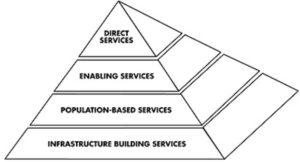Question
How should cultural and community practices be considered in the design and implementation of public health programs at each level of the public health pyramid?
Solution
Hello class,
According to Issel (2014), the public health pyramid is evidenced to comprise four levels. These are identified as infrastructure services, direct health services, population-based services, and enabling services (see figure 1).
Figure: Public health pyramid
Source:(Kaye et al., 2001)
Direct services
It is crucial that the cultural needs of the patient are taken into consideration in the context of direct services within the public health programs. This ties to the fact that the health interventions implemented at the direct health level have a more direct effect, and the targeted population is more confined. This occurrence makes it vital for cultural preferences and needs to be integrated into medical care. Among areas to be considered may comprise aspects such as religious beliefs, and language (Jongen et al., 2017). In relation to language, the intervention material can be translated and subsequently presented in the patient’s preferred language. On the other hand, when it comes to religious beliefs, the patient’s background ought to be factored in rather than disregarded even as they are encouraged to embrace the interventions that will work best for them.
Enabling services
Issel (2014) describes the enabling services level as one which incorporates interventions aimed at benefitting a particular group or community…Kindly click on the purchase icon to access the full solution at $5

